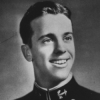Alan Shepard

Alan Shepard
Rear Admiral Alan Bartlett "Al" Shepard Jr.was an American naval officer and aviator, test pilot, one of the original NASA Mercury Seven astronauts, and businessman, who in May 1961 made the first manned Mercury flight. Shepard's craft entered space, but did not achieve orbit. He became the second person, and the first American, to travel into space, and the first person to manually control the orientation of his spacecraft...
NationalityAmerican
ProfessionAstronaut
Date of Birth18 November 1923
CityDerry, NH
CountryUnited States of America
On the periscope . . . . What a beautiful view. Cloud cover over Florida - three to four tenths near the eastern coast. Obscured up to Hatteras . . . I can see [lake] Okeechobee. Identify Andros Island. Identify the reefs.
Why don't you fix your little problem and light this candle?
Obviously I was challenged by becoming a Naval aviator, by landing aboard aircraft carriers and so on.
But when I was selected, after my very first tour of squadron duty, to become one of the youngest candidates for the test pilot school, I began to realize, maybe you are a little bit better.
The excitement really didn't start to build until the trailer - which was carrying me, with a space suit with ventilation and all that sort of stuff - pulled up to the launch pad.
Then there was the challenge to keep doing better and better, to fly the best test flight that anybody had ever flown. That led to my being recognized as one of the more experienced test pilots, and that led to the astronaut business.
Roger, liftoff, and the clock is started.
Got more dirt than ball. Here we go again.
When I first looked back at the Earth, standing on the Moon I cried
I know you're all saying I can go to the moon but I can't find Pasadena.
You know, being a test pilot isn't always the healthiest business in the world.
I guess those of us who have been with NASA ... kind of understand the tremendous excitement and thrills and celebrations and national pride that went with the Apollo program is just something you're not going to create again, probably until we go to Mars.
You've done it in the simulator so many times, you don't have a real sense of being excited when the flight is going on. You're excited before, but as soon as the liftoff occurs, you are busy doing what you have to do.
Miles and miles and miles.